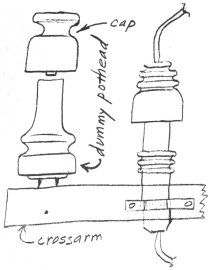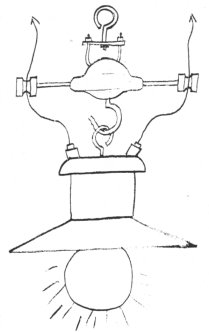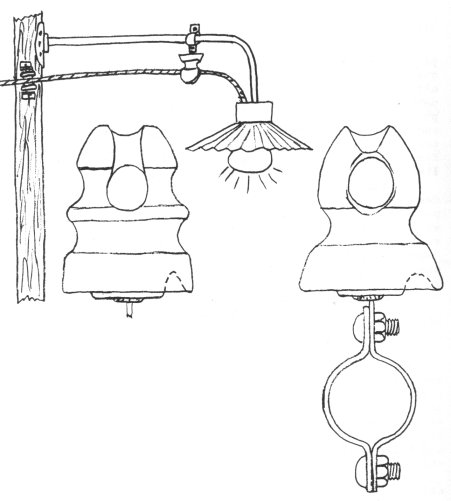Porcelain Insulator News
by Jack H. Tod
Reprinted from "INSULATORS - Crown Jewels of the Wire", October 1972, page 24
Tom Kasner (Bend, OR.) recently reported having dug some nice porcelains in
an old dump. These are 9 1/4" multis which appear to be the early Locke
#315. They have the early Locke tradename "VICTOR" and are glazed a
pretty, light blue-green color. Since Tom collects only glass, he wants to trade
these and shouldn't have any trouble there.
A number of collectors have reported having the U-47 pin type with the
"F E D C 0" crown marking shown on page 22 of July. One collector also
has this in white. These could turn out to be more readily available in time,
but I have to rate them as TUF presently.
Ben Hong (Richardson, Texas) reports what I consider an unusual Illinois
"advertiser" item. This is a brass box for paper clips, etc. Embossed
on both outside and inside the cover is the Illinois map outline with insulator
atop it and "MACOMB, ILL." below it. Porcelain advertisers are not
uncommon, but this brass box one in very unusual.
Larry Harmon (Wentzville, Mo.) called to make a preliminary report an a new
porcelain threadless a friend dug in an old dump, and which Larry now owns .
Sounds like a nice new find, and we'll get a drawing or photo of it in the
column as soon as the mails will allow.
Several Locke specialists and other knowledgeable porcelain collectors have
reported finding various early Locke items with the "wordy" markings
of under-glaze type instead of the customary incuse handstamps. All of these
thus far have been on white specimens and with either blue or black u-g ink,
except for one solitary specimen of the marking on the light tan (butterscotch)
color. Everyone has indicated this under-glaze marking is rare for early Locke
items, and I am quick to agree with that.
An usual, I goofed - more than once, of course. On page 20, July, the Oakman
patent was referred to as "the Roman helmet type of tie", whereas the
patent covers the internal skirt threads on glass insulators. On page 18,
August, I neglected to mention the full-date marking which is currently being
used on pin types by Pinco.
We've had such good luck so far, maybe a reader can tell us what the hole
through the crown of the U-70 (at right) is for.

Dear Jack:
On page 23 of July 1972 is a picture of a dummy pothead and a question as to
what it was. I am attaching a crude sketch of the device and its use. The
pothead provides a method of terminating and sealing the underground cable from
moisture and a means for disconnecting the overhead line from the underground
cable.

When disconnecting, the dummy cap is placed over the pothead, and the pothead
cap with flexible cable is placed over the dummy pothead. The dummy pothead
shown in July was used extensively from about 1920 to 1950 on circuits up to
5000 volts, and there are several still in use today.
I am also enclosing a rough sketch showing how the "Triple Insulator
Arm" was used as collectors have guessed wrong about this one. Since
series-connected street lights operate at loop voltages up to 8 to 10Kv total,
this insulator was designed to insulate the lamp fixture from the mast arm and
to provide insulated supports for the lead wires to the overhead wires, thus
removing the strain from the fixture terminals themselves.

There are other
versions of this insulator, but each one has the center porcelain piece and the
porcelain spools at the ends of the extended arm . By the way, I have two insulators which have been in my possession since 1924 at which time I started
collecting insulators. I noticed in some previous issue of Insulators that
someone had been collecting insulators for eight years and claimed to be one of
the earliest collectors.
Yours very truly,
Frank Donnelly
3905 Central Ave.
Western Springs, Il. 60558
Many thanks, Frank. Our curiosity on these items was near the boiling point.
Your 48 years of collecting is hard to top. J. Tod

Dear Jack:
I have an insulator (right above) that was found here in Frankfort, and it
was used as I've sketched it (above). The metal bracket is held in with a lead
allay, and would it harm the insulator if a torch was used to melt the lead? If
you have any information such as origin, manufacturer, use, value, etc. please
let me know.
Mike Dawkins, Frankfort, Ky.
Answer:
These "pipe mounting wireholders" are a standard item of
manufacture, and I've shown another one (left above) I have with "FINDLAY
1938" marking. And this is also a good place to relate that all theme
numbers in the 1900-2000 block on Findlay (and later P.P. Inc.) wireholders are
their catalog numbers and not dates. Although yours isn't marked, I would guess
it is also a P.P. Inc.
The unusual thing about these particular ones in that they are of a petticoat design, whereas the more normal wireholders with lag
screws and threaded studs have a flat base. Unaltered, it would have a trade
value of several dollars. You can melt the lead alloy carefully with a torch but
then you won't have an "insulator" - just a hunk of porcelain and a
pile of metal. Everyone to himself in how and what he collects, but I personally
collect insulators for what they are and don't subscribe to the practice of
removing the hardware (or "Junk", some say). J. Tod
| 